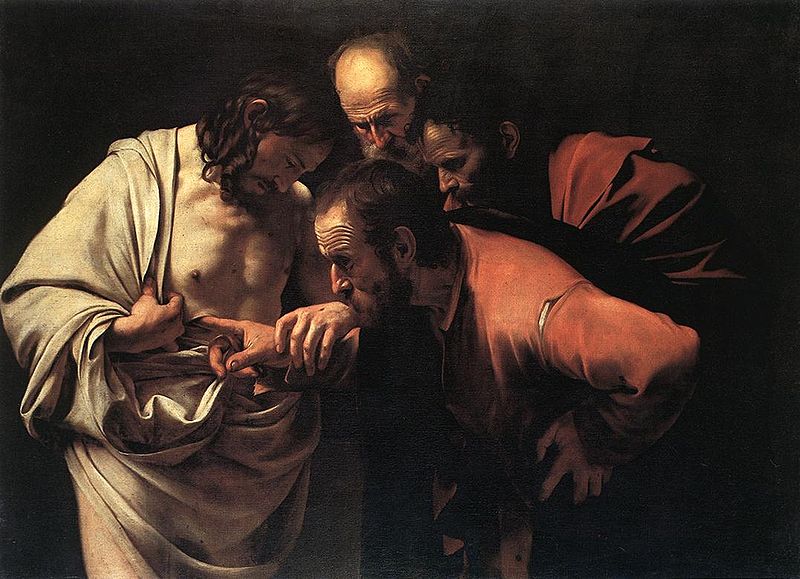Caravaggio’s The Incredulity of Saint Thomas, 1601
From the Late Notebooks:
When Jesus says “I am the way” [John 14:6] time stops. There is no journey through unknown country: all the disciples have to do is walk through the open door (another “I am” metaphor [John 10:9]) of the body in front of them). That is, I think, impossible before the Resurrection. Perhaps everything that happens in the gospels is not an event but a ticket to a post-Resurrection performance. Except that the spiritual reality is not so much future as an expansion of the imaginative possibilities of the present. The myth confronts: it doesn’t prophesy in the sense of foretelling. (CW, 5, 159)
Jesus is not “a” historical figure: he’s dropped into history as an egg is into boiling water, as I said [par. 301], and essentially “the” historical Jesus is the crucified Jesus. One can understand why the Gnostics tried to insist that the crucifixion was an illusion, but nobody can buy that now. The pre-Easter Jesus answers the question: ‘Can a revolt against Roman power succeed?”
The answer is no, and the pre-Easter Jesus sums up the history of Israel, which is a history of “historical” failure. (CW, 5, 170)
The Resurrection, then, is the marriage of a soul & body which forms the spiritual body. The body part of this marriage is female: the empty tomb is recognized solely by women, except perhaps for that fool who stuck Peter into John’s account [20:1-10]. (Perhaps the “and Peter” of Mark [16:7] was stuck in too.) The fact that Jesus took on flesh in the Virgin’s womb has certainly been dinned into Christian ears often enough; but the fact that he took on flesh in the womb of the tomb at the Resurrection, and that there’s a female principle incorporated in the spiritual body, seems to have been strangled. The real tomb of Christ was the male-guarded church. (CW, 5, 327)
The historical Jesus is a concealed though essential element in the Gospels: if the Gospels’ writers had simply made up the Jesus story they would still be superb works of literature, but of course they wouldn’t be gospels. The myth is what they literally are, though: they don’t present Jesus historically. Historically, Jesus is a man until the Resurrection, when he becomes an element in everyone, implying that no one can be “saved” (meaning the indefinite persistence of something like an ego in something like a time and space) outside or before Jesus. Presented as a myth in the eternal present, this doctrine takes on a more charitable appearance. The Word and Spirit in man then coincide into something that has its being in God (as God has his being in it) to such an extent that the question of belief in “a” God doesn’t arise. (CW, 6, 671)
From CBC radio “Rewind”, various Easter broadcasts dating back to the 1940s, including Frye in 1973 on Easter myths and symbols (beginning at the 24 minute mark).

